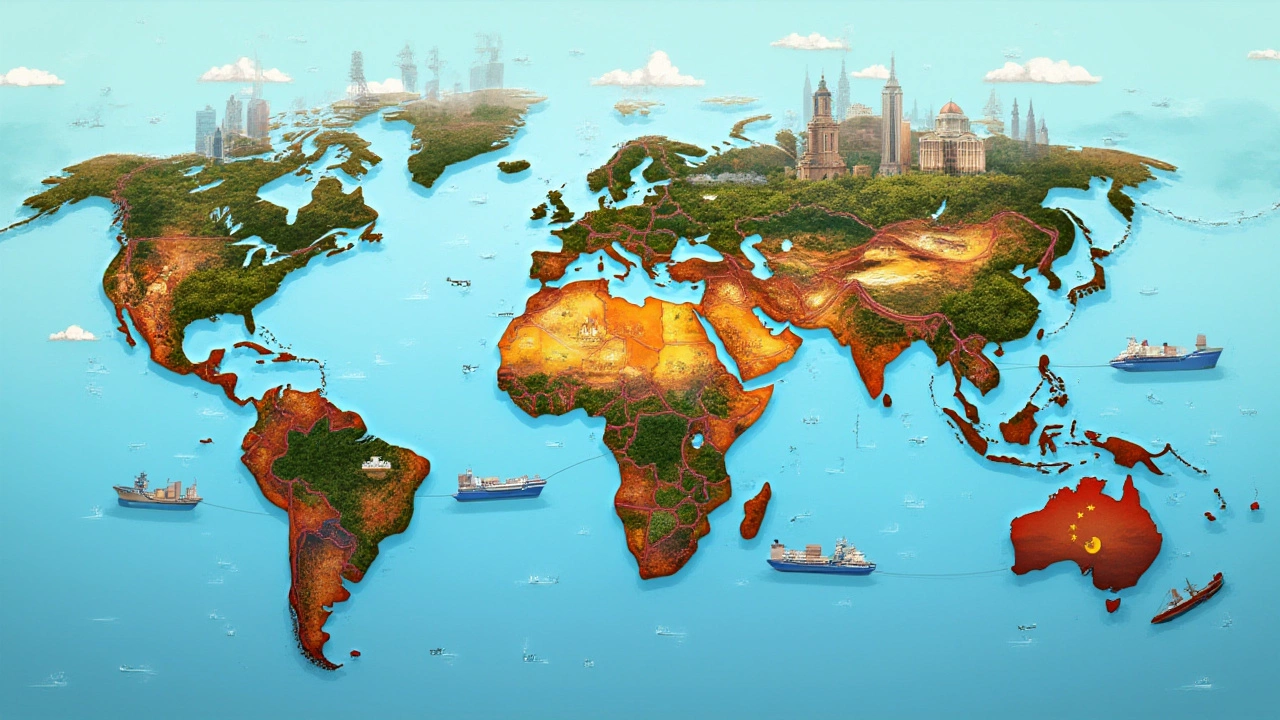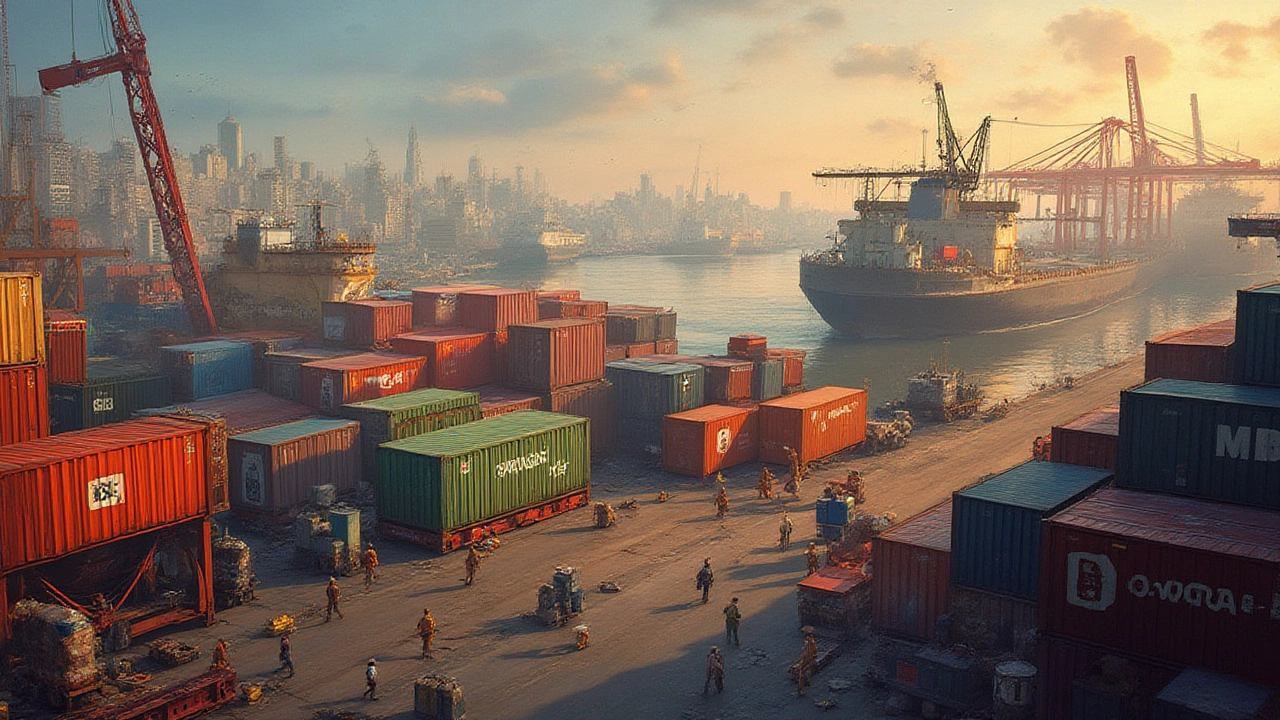 Jul, 19 2025
Jul, 19 2025
Imagine the world without chemicals: no medicines, no plastics, no paints, even agriculture would grind to a halt. Now picture a handful of powerhouse countries quietly running this massive behind-the-scenes trade that touches every corner of your day-to-day life. One country, though, sits at the very top of the chemical world, shipping out mind-boggling amounts of essential materials and products every year.
Why Countries Race to Lead Chemical Exports
You probably don’t stop to think about chemical exports when you open a soda can or brush your teeth. But chemicals are the backbone of modern life. Nations that dominate this trade pull a huge amount of economic weight. Chemicals aren’t just raw goop in barrels: they’re everything from fertilizers and resins to high-tech polymers and pharmaceutical ingredients. With the global chemical market valued at around $5.4 trillion in 2024, you get a sense of why ranking high here matters.
But here’s a thing most don’t realize: chemical exports aren’t just about having big factories. It’s also about research power, logistics, government support, and international partnerships. Germany, for example, made chemistry famous with BASF and Bayer, while the U.S. powers forward with giants like Dow and DuPont. But which country actually sells the most chemicals abroad year after year?
Before jumping to the winner’s spot, it helps to look at why countries are so obsessed with building their chemical manufacturing sectors. First off, it’s jobs. Chemical plants—from basic commodity chemicals right up to advanced biotech—employ millions. Second, chemicals themselves are the ingredients for almost everything else: cars, electronics, food, and even clean energy. Third, the sector invites investment and supports huge export surpluses, which lets countries build their economies and flex global influence.
Chemical exports also reveal how advanced (or not) a country’s manufacturing scene is. The more complex the chemical exports, the more innovation a country can claim. Governments pour money into R&D, education, and transport just so their industries can stay at the top of this game. The winner? That badge grabs headlines, investors, and plenty of deals far outside the chemistry world.
Germany: The King of Chemical Exports
If you had to guess who’s wearing the crown for chemical exports, chances are you’d think of either the United States or China. But, the real heavyweight champion is Germany. Not only does Germany lead the pack in total value, but it also stands out for exporting high-quality, cutting-edge chemicals. According to the WTO’s latest data for 2024, Germany exported more than $220 billion worth of chemicals. That figure puts it ahead of China, whose chemical exports have surged but still lag slightly behind Germany’s.
Let’s put that into real-world perspective. German companies supply chemicals to almost every country you can name. Their expertise goes way beyond just volume—they specialize in everything from plastics to specialty chemicals, which get used in industries like automotive, healthcare, construction, and electronics. Firms like BASF, Bayer, Merck, and Evonik aren’t just industry names—they’re legends, fueling innovation everywhere from crop science to battery tech.
What’s Germany’s secret sauce? Part of it is historical. For well over a century, Germany invested in chemistry as a key industry. Their universities work hand in hand with companies, whipping up new discoveries and pushing them into full-scale manufacturing. Second, German firms obsess over efficiency and precision (think: world-famous engineering standards). Add in a location smack in the heart of Europe, with great roads, rivers, and ports, and you get a recipe for cost-effective exports at massive scale.
Here’s a quick look at 2024’s top chemical exporters based on WTO and Eurostat data:
| Country | Chemical Export Value (Billion USD) |
|---|---|
| Germany | 220 |
| China | 210 |
| United States | 195 |
| Belgium | 95 |
| Netherlands | 75 |
So, despite China’s incredible pace, Germany manages to keep its lead thanks to quality, innovation, and high-end production. It’s not just about shipping buckets of raw chemicals—specialty products, custom formulations, and high standards help Germany keep the edge.

How China and the U.S. Challenge Germany’s Reign
Germany may be on top for now, but the distance between first, second, and third is shrinking fast. China has doubled its chemical exports since 2015, fueled by massive government support, cheap labor, and a no-holds-barred push into specialties like electronics materials, agrochemicals, and pharmaceuticals. The U.S. is also a heavyweight, thanks to abundant natural gas (crucial for plastics and fertilizers), a strong innovation culture, and giants like Dow Inc., DuPont, and ExxonMobil Chemical.
The real twist? China is betting hard on advanced chemicals. In the old days, Chinese exports meant low-cost, low-quality. Now, Chinese companies make high-purity polymers, battery chemicals for electric cars, and even cutting-edge pharmaceutical ingredients. If you look at where new factories are popping up, China invests billions in "chemical parks" that cluster companies together, pump out research, and crank up exports across Asia, Africa, Europe, and America.
Not to be forgotten, the U.S. brings its own strengths: a gigantic home market, plenty of natural resources, and the world’s best chemical engineers. The shale gas revolution made Americans super competitive in ethylene, propylene, and plastics—core building blocks for everything from food packaging to smart gadgets. Plus, the U.S. exports a ton of specialty chemicals: think advanced adhesives, lightweight composites, and even next-gen bio-based plastics.
While Germany leans toward high-value chemicals going to Europe and the U.S. (close trading partners), China ships huge cargoes to the rest of Asia, Africa, and South America—a sign of shifting global ties. Meanwhile, the U.S. relies on complex free-trade agreements and direct investment in global markets. There’s no single path to chemical export greatness—it’s a dogfight of talent, resources, and smart tactics.
Secret Weapons: How Top Exporters Stay Ahead
No one stays the top chemical exporter by accident. Germany, China, and the U.S. all have “secret weapons” that make the difference.
- Research muscle: German companies spend around 5% of revenue on R&D, while Chinese firms get government grants for technological leapfrogging. U.S. chemical companies, linked to the world’s top universities, create powerful global research networks.
- Great infrastructure: It’s not just about factories. Germany’s dense rail network, deep-water ports, and well-oiled highways keep goods moving fast. China’s built colossal logistics hubs, speeding exports across the globe.
- Regulatory agility: The U.S. and Germany work with strict environmental rules, which pushes firms toward cleaner, safer processes—a selling point as customers demand green chemicals. China, still catching up here, uses government speed to approve new investments at breakneck pace.
- Smart workforce: Chemistry isn’t just pushing buttons on machines. All three countries invest in training, apprenticeships, and lifelong learning for workers. That means better quality, fewer mistakes, and more creative production processes.
- Diversified export markets: Germany exports heavily within Europe but also targets North America and Asia. The U.S. focuses on Canada and Mexico plus a sprawl of distant countries. China chases fast-growing neighbors and new “Belt and Road” partners from Africa to Latin America.
Want a tip? If you run a business in sectors like automotive, electronics, or pharmaceuticals, get to know these exporters up close. Sourcing partnerships with the top chemical makers can mean better prices, shorter development cycles, and early access to cutting-edge products. Oh, and keep an eye on trade policies—tariffs hit chemicals hard, so expect sudden changes as global politics shift.

Watch the Future: Disruptions, Sustainability, and New Players
No one expected Germany to hold the lead for so long, but disruptions come fast. Sustainability is crashing into the chemicals market, shifting the pecking order. Green chemistry—meaning less pollution, fewer fossil fuels, and more recycling—is catching fire in the EU. Germany’s top companies sign billion-euro deals to build plants running on renewable energy, while research centers crank out bio-based plastics and new battery materials.
China’s catching up, too. They’re piloting mega-factories that convert waste into chemical feedstocks and aiming to dominate in EV battery chemicals. The U.S. is hunting for the next big thing in biodegradable polymers, smart coatings, and carbon capture chemicals—stuff that could upend the boring world of commodity chemicals with something greener and richer.
But here’s the curveball: new countries want in. India doubled its chemical exports in the last decade and is chasing big investments in pharma ingredients. South Korea and Japan are also flexing muscle, especially in electronics materials (think chipmaking chemicals). That means Germany’s hold is strong but never guaranteed. Companies that adapt fast—watching regulations, investing in green chemistry, and mastering high-tech exports—are the ones that’ll steal the show.
- Stay curious about changing regulations—green laws shift markets fast.
- Get smart about cross-border risks—tariffs and sanctions can upend deals overnight.
- Chase hot markets early: battery chemicals, electric vehicle materials, and new polymers pay off big.
If you’re trying to choose suppliers, invest, or even work in the chemical sector, keep a close eye on the leaders—but don’t be fooled, new players could shake up the rankings. The chemical trade is a wild ride, tied straight to the world’s biggest industries and future tech.